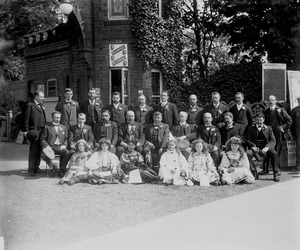Rosherville Gardens facts for kids
Rosherville Gardens was a famous fun park in the 1800s. It was built in an old chalk quarry in Northfleet, Kent, England. The gardens opened in 1837 and stayed open for about 70 years, closing just before World War I.
Even today, some parts of Rosherville Gardens still exist. You can find an old bear pit, a special entrance and tunnel through the cliff, a hermit's cave, and parts of an Italian garden. There's also an interesting cave called the Enigmatic Cavern, along with a drawdock and quay which was the river entrance.
Contents
What Were Rosherville Gardens Like?
The gardens were created in 1837 by George Jones, a businessman from London. They covered a large area of 17 acres (about 69,000 square meters) in an old chalk quarry in Northfleet. Their full name was the 'Kent Zoological and Botanical Gardens Institution'.
The land for the gardens belonged to Jeremiah Rosher. From 1830, he started building a new town called Rosherville. He wanted to take advantage of how popular Gravesend was with Londoners who visited for the day by steamboat on the River Thames. The gardens quickly became a favourite spot for thousands of Londoners, especially on sunny days. Many people traveled by paddle steamer down the Thames and got off at a special pier built just for the gardens.
A Sad Day on the River
In 1878, a steamboat that had left Rosherville pier was involved in a terrible accident. The passenger ship, called the SS Princess Alice, crashed into another ship, the Bywell Castle. This happened near Woolwich, a mile downstream. Sadly, 640 people died in the collision, and 240 of them were children. An investigation was held, but no clear reason was ever found for what caused the disaster.
Famous People and Fun Acts
At one point, the gardens were managed by Barnet Nathan. He was known as 'Baron Nathan' and was famous for his amazing act: he would dance a hornpipe (a type of dance) while blindfolded across a stage covered with eggs!
Why Did the Gardens Close?
In 1886, a nearby railway station opened, making it easier to get to Rosherville. However, the growth of railways also led to the gardens' decline. Londoners could now travel further and reach coastal towns like Margate and Southend easily. These new destinations offered different kinds of fun, and fewer people visited Rosherville Gardens.
Robert Hiscock, in his book A History of Gravesend, described the gardens beautifully:
They were a place of great beauty and a favourite spot for Londoners. They had small Greek temples and statues placed in the cliffs. There were also terraces, a lawn for archery, a small theatre called the Bijou, and a large hall called the Baronial Hall for food and drinks. At one time, there was even a lake. At night, the gardens shone with thousands of colourful lights, and there were fireworks shows and dancing. Famous bands, like the American Sousa band, played there during the season. Blondin, a famous trapeze artist, also performed. In 1857, as many as 20,000 visitors came through the gates in just one week. By 1880, the gardens were at their most popular. They finally closed in 1901.
During a short time when they reopened (1903-1911), they were used to make some of the very first films.
What's Left of the Gardens Today?
In 2012, during digging for a new building project, the original bear pit from the centre of the gardens was uncovered. It was then protected as a Grade II listed site in 2014. In 2016, plans for new homes on the site suggested leaving the pit buried and marking its location with a special plaque.
Parts of the Cliff Top Entrance, built in 1869, still remain. The statues that were once there were moved to a nearby area. The front part of the entrance was removed when a factory was built on the site. However, the staircase that winds through the cliff is still there. You can even see bits of the old gas-lighting pipes and an iron handrail. The original path down was removed, and a metal staircase was put in for factory workers during the war.
Rosherville in Books
Rosherville Gardens was so famous that it was mentioned in many books and plays!
For example, it appears in The Newcomes by William Makepeace Thackeray. It's also mentioned in the funny opera Cox and Box by Francis Burnand and Arthur Sullivan from 1866.
Later, in 1877, Gilbert & Sullivan's opera "The Sorcerer" also mentions Rosherville. A character sings, "Hate me! I sometimes go to ROSHERVILLE!", and another replies, "Love me! that joy I'll share!".
Robert Louis Stevenson mentioned it in his writing about Fontainebleau in 1882. Even P. G. Wodehouse included it in his first Jeeves story, Jeeves Takes Charge.
E. Nesbit called it "a place to spend a happy day" in her book The Story of the Amulet. George Gissing's short story Lou and Liz (1893) is almost entirely set in Rosherville Gardens.
It's also mentioned by R.S.S. Baden-Powell in his 1915 book Memories of India. Henry James mentioned the gardens in his story An International Episode and in a travel piece.
The band Kaprekar's Constant released songs called "Rosherville" Parts 1 and 2 in 2019. These songs tell the story of how the gardens were built and how they eventually closed, even mentioning the Princess Alice Disaster.



